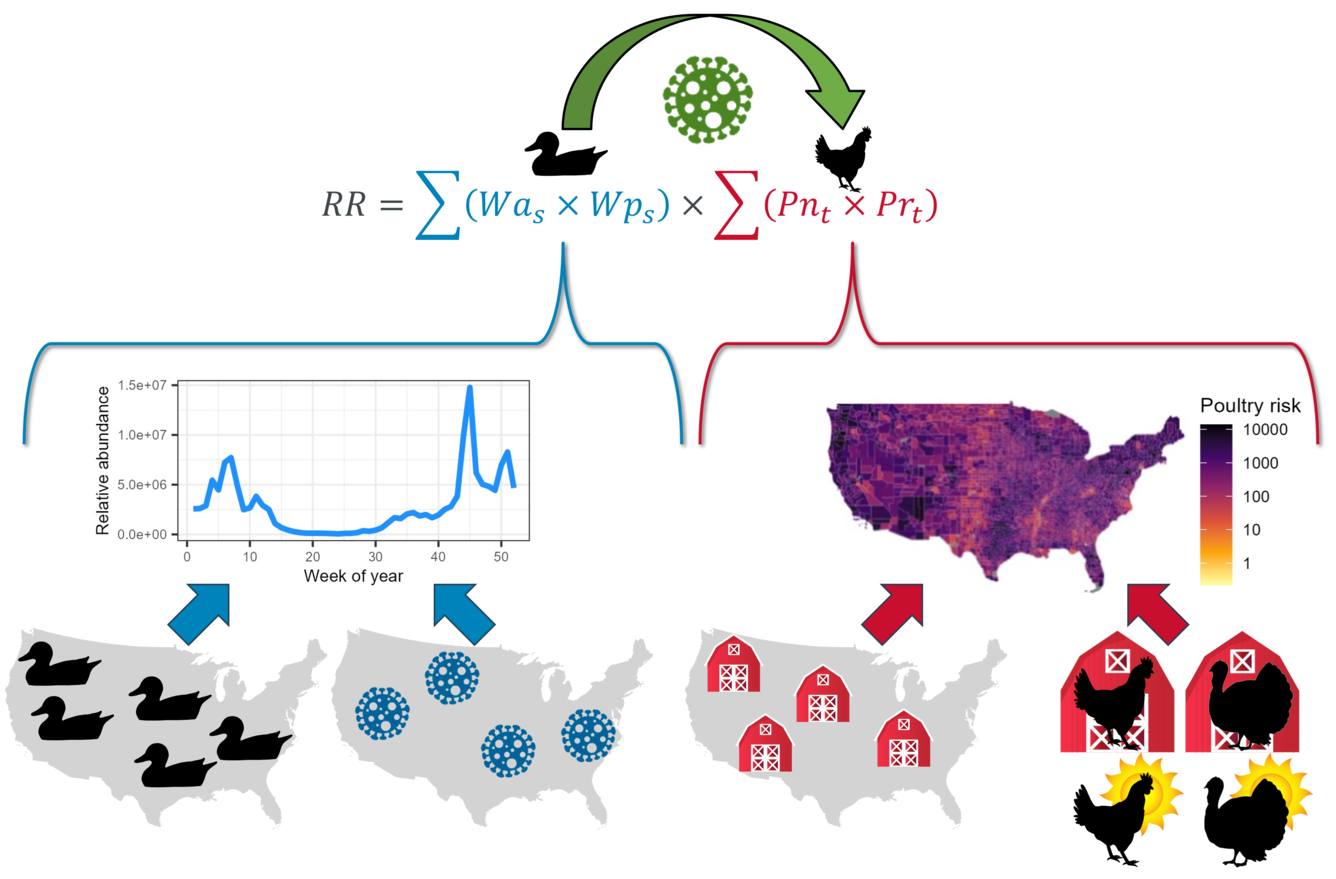Advancing Risk Modeling for Highly Pathogenic Avian Influenza
Ongoing global outbreaks demonstrate the capacity of highly pathogenic avian influenza virus (HPAIV) to impact poultry, wild birds, and even human health. USGS research is advancing the understanding of the spatial and temporal interface between wild and domestic bird populations from which these viruses emerge to aid biosecurity planning and outbreak response.
Avian influenza received international concern following the 2005 outbreak in Qinghai Lake, China that killed over 6,000 wild waterfowl. While low pathogenic strains of avian influenza (LPAI; designated as such because it does not kill chickens) circulate naturally in wild waterfowl, the disease can rapidly mutate into highly pathogenic avian influenza (HPAI; which does kill chickens) when it gets introduced to poultry operations where domestic birds are kept at high densities.
Though the issue of avian influenza has been of greatest concern in Asia where the disease has caused mass mortality events in wild waterfowl and several outbreaks in humans, the United States has also been confronted with avian influenza in both wild birds and domestic poultry. For instance, during the December 2014 – June 2015 HPAI outbreak alone, approximately 50 million chickens and turkeys died either directly as a result of HPAI or as part of a disease control effort, costing the poultry industry an estimated 879 million dollars.
The United States was once again challenged by the introduction of H5N1 in January 2022, with detections in wild birds soon spilling over to domestic poultry operations throughout the nation. The continued threat avian influenza poses to an important agricultural industry demonstrates the need for active research into how to best prepare for and prevent spillover events.
Use the links above to explore USGS research into transmission interface modeling efforts in the United States and Asia.
<< Back to Avian Influenza Research at EESC

Avian influenza spillover into poultry: Environmental influences and biosecurity protections Avian influenza spillover into poultry: Environmental influences and biosecurity protections
Landscape changes elevate the risk of avian influenza virus diversification and emergence in the East Asian–Australasian Flyway Landscape changes elevate the risk of avian influenza virus diversification and emergence in the East Asian–Australasian Flyway
Using an adaptive modeling framework to identify avian influenza spillover risk at the wild-domestic interface Using an adaptive modeling framework to identify avian influenza spillover risk at the wild-domestic interface
Identifying an understudied interface: Preliminary evaluation of the use of retention ponds on commercial poultry farms by wild waterfowl Identifying an understudied interface: Preliminary evaluation of the use of retention ponds on commercial poultry farms by wild waterfowl
Pathways for avian influenza virus spread: GPS reveals wild waterfowl in commercial livestock facilities and connectivity with the natural wetland landscape Pathways for avian influenza virus spread: GPS reveals wild waterfowl in commercial livestock facilities and connectivity with the natural wetland landscape
The spatial-temporal relationship of blue-winged teal to domestic poultry: Movement state modeling of a highly mobile avian influenza host The spatial-temporal relationship of blue-winged teal to domestic poultry: Movement state modeling of a highly mobile avian influenza host
Waterfowl occurrence and residence time as indicators of H5 and H7 avian influenza in North American Poultry Waterfowl occurrence and residence time as indicators of H5 and H7 avian influenza in North American Poultry
Confronting models with data: The challenges of estimating disease spillover Confronting models with data: The challenges of estimating disease spillover
Spatial modeling of wild bird risk factors to investigate highly pathogenic A(H5N1) avian influenza virus transmission Spatial modeling of wild bird risk factors to investigate highly pathogenic A(H5N1) avian influenza virus transmission
Mapping risk of avian influenza transmission at the interface of domestic poultry and wild birds Mapping risk of avian influenza transmission at the interface of domestic poultry and wild birds
Spatial distribution and risk factors of highly pathogenic avian influenza (HPAI) H5N1 in China Spatial distribution and risk factors of highly pathogenic avian influenza (HPAI) H5N1 in China
Visualizing Models for Avian Influenza Viruses Visualizing Models for Avian Influenza Viruses
Ongoing global outbreaks demonstrate the capacity of highly pathogenic avian influenza virus (HPAIV) to impact poultry, wild birds, and even human health. USGS research is advancing the understanding of the spatial and temporal interface between wild and domestic bird populations from which these viruses emerge to aid biosecurity planning and outbreak response.
Avian influenza received international concern following the 2005 outbreak in Qinghai Lake, China that killed over 6,000 wild waterfowl. While low pathogenic strains of avian influenza (LPAI; designated as such because it does not kill chickens) circulate naturally in wild waterfowl, the disease can rapidly mutate into highly pathogenic avian influenza (HPAI; which does kill chickens) when it gets introduced to poultry operations where domestic birds are kept at high densities.
Though the issue of avian influenza has been of greatest concern in Asia where the disease has caused mass mortality events in wild waterfowl and several outbreaks in humans, the United States has also been confronted with avian influenza in both wild birds and domestic poultry. For instance, during the December 2014 – June 2015 HPAI outbreak alone, approximately 50 million chickens and turkeys died either directly as a result of HPAI or as part of a disease control effort, costing the poultry industry an estimated 879 million dollars.
The United States was once again challenged by the introduction of H5N1 in January 2022, with detections in wild birds soon spilling over to domestic poultry operations throughout the nation. The continued threat avian influenza poses to an important agricultural industry demonstrates the need for active research into how to best prepare for and prevent spillover events.
Use the links above to explore USGS research into transmission interface modeling efforts in the United States and Asia.
<< Back to Avian Influenza Research at EESC




